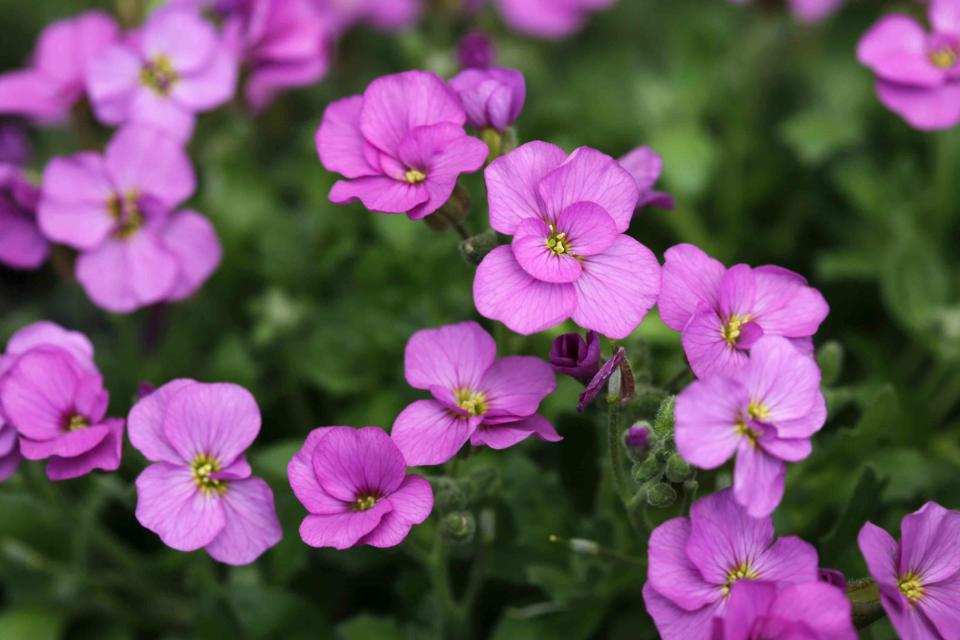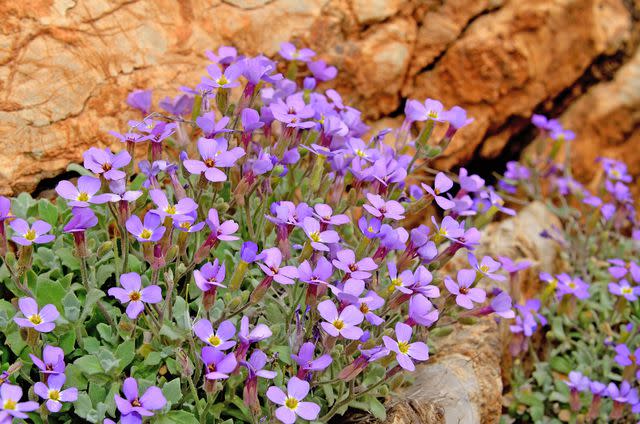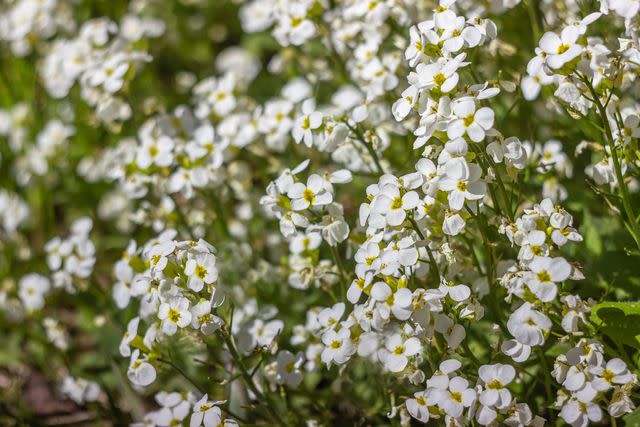How to Grow and Care for Rock Cress Like a Pro
Rock cress is a charming perennial plant that adds beauty to any garden.

Joshua McCollough / Getty Images
Rock cress, also known as Arabis, is a charming and resilient perennial plant that adds beauty and texture to any garden or landscape. With its delicate flowers and creeping habit, rock cress is a favorite choice for rock gardens, borders, and containers.
To ensure your rock cress thrives and flourishes, it's essential to provide the proper care and maintenance. In this article, we'll explore expert tips and techniques for nurturing your rock cress, from planting to pruning, to help you cultivate a vibrant and flourishing garden display.
Common Name | Rock Cress |
Botanical Name | Aubrieta deltoidea |
Family Name | Arabis |
Plant Type | Perennial ground cover |
Mature Size | 4 to 9 in tall |
Sun Exposure | 6 hours |
Soil Type | Well-drained soil |
Soil pH | 6.5 to 7.5 |
Hardiness Zones | USDA zones 4 to 7 |
Native Area | North America |
Toxicity | Non-toxic |
How to Grow and Care for Rock Cress
Here are the main care requirements for growing Rock Cress:
Plant in well-drained soil: Rock cress thrives in soil that drains well, preventing waterlogging and root rot.
Provide full sun: Ensure your rock cress receives ample sunlight, ideally at least six hours of direct sunlight daily, to promote healthy growth and prolific flowering.
Water moderately: While rock cress is drought-tolerant once established, it's essential to water newly planted specimens regularly until they establish roots. Afterward, water sparingly to avoid waterlogged soil.
Apply a balanced fertilizer: Feed your rock cress with a balanced fertilizer in spring to encourage robust growth and abundant blooms.
Mulch to retain moisture: Apply a layer of organic mulch around the base of the plant to retain soil moisture, suppress weeds, and regulate soil temperature.
Prune after flowering: Trim back spent flowers to encourage additional blooms and maintain a neat appearance. Cut back any leggy or overgrown stems to promote bushy growth.
Divide every few years: Divide mature rock cress plants every few years to rejuvenate them and prevent overcrowding. Replant divisions in well-prepared soil for continued vigor.
Protect from pests and diseases: Monitor for pests such as aphids and caterpillars, and treat infestations promptly. Additionally, ensure good air circulation around plants to prevent fungal diseases.
Want more gardening tips? Sign up for our free gardening newsletter for our best-growing tips, troubleshooting hacks, and more!

Tamer Yilmaz / Getty Images

Elena Ga / Getty Images
Light
Rock cress requires full sun to thrive, ideally receiving at least six hours of direct sunlight daily. Adequate sunlight is crucial for promoting healthy growth and abundant flowering in this resilient perennial plant.
Soil
Rock cress thrives in well-drained soil that is slightly acidic to neutral in pH. It prefers soil that is nutrient-rich and has good drainage to prevent waterlogging, which can lead to root rot. Additionally, rocky or sandy soil types mimic its natural habitat and are ideal for promoting healthy growth.
Water
Rock cress, once established, is remarkably drought-tolerant and requires minimal watering. Water newly planted specimens regularly to help them establish roots, but once mature, water sparingly to prevent waterlogged soil.
Overwatering can lead to root rot, so it's crucial to let the soil dry out between watering sessions. Generally, rock cress thrives with moderate moisture levels, making it an ideal choice for low-maintenance landscapes.
Temperature and Humidity
Rock cress thrives in moderate temperatures and prefers cooler climates, ideally between 50°F to 75°F. It tolerates a wide range of humidity levels, but it generally prefers moderate humidity, avoiding excessively dry or humid conditions.
Fertilizer
For optimal growth, choose a balanced fertilizer with an N-P-K ratio of 10-10-10 or similar. Apply the fertilizer in early spring, following package instructions carefully to avoid over-fertilization, which can harm the plant.
Types of Rock Cress
While the classic rock cress variety is most common, there are several cultivars available, each offering unique characteristics:
Snowcap Rock Cress: This variety of rock cress produces masses of pure white flowers in early spring, creating a stunning contrast against its dark green foliage. It forms low, spreading mounds and is ideal for rock gardens and borders.
Old Gold Rock Cress: 'Old Gold' rock cress is characterized by its striking golden-yellow foliage, which provides year-round interest in the garden. In spring, it produces clusters of small white flowers that further enhance its appeal.
Compinkie Rock Cress: 'Compinkie' rock cress is a compact and floriferous variety, featuring delicate pink flowers that blanket the plant in early spring. Its low-growing habit makes it perfect for edging pathways or planting in containers.
Pruning
To prune rock cress effectively, trim back spent flower stems after the blooming period to encourage additional blooms and maintain a tidy appearance. Use sharp scissors or pruning shears to cut the stems just above a set of healthy leaves or a lateral bud.
Additionally, remove any leggy or overgrown stems to promote bushy growth and maintain the plant's compact form. Avoid cutting into old wood, as this can inhibit new growth.
Propagating Rock Cress
Here's how to propagate rock cress by cuttings:
Select non-flowering stems with at least three sets of leaves, preferably taken in spring or early summer.
Remove the lower leaves from the stem, leaving only a few at the top to reduce moisture loss.
Dip the cut end of each stem in rooting hormone powder to encourage quicker root development.
Insert the prepared cuttings into a well-draining potting mix, ensuring the nodes where leaves were removed are buried.
Keep the cuttings consistently moist but not waterlogged, and place them in a warm, bright location with indirect sunlight.
Over the next few weeks, monitor the cuttings for signs of root development, such as new growth or resistance when gently tugged.
Once roots have formed, transplant the rooted cuttings into individual pots or a prepared garden bed, ensuring they receive adequate water and sunlight as they establish.
How to Grow Rock Cress from Seed
Begin rock cress seeds indoors about 6-8 weeks before the last frost date in your area. Here are the steps to grow rock cress from seeds:
Sow the seeds in seed trays or small pots filled with a well-draining seed-starting mix.
Press the seeds lightly into the soil surface, but do not cover them with additional soil as they require light to germinate.
Keep the soil evenly moist but not waterlogged by misting or bottom-watering the trays.
Place the trays in a warm location with indirect sunlight or under grow lights to encourage germination.
Once the seedlings have developed several true leaves, transplant them into individual pots or a prepared garden bed.
Gradually acclimate seedlings to outdoor conditions by exposing them to increasing periods of sunlight and outdoor temperatures over the course of a week.
After the danger of frost has passed, plant the hardened-off seedlings in their permanent outdoor location, spacing them according to the specific variety's requirements.
Potting and Repotting Rock Cress
To pot rock cress, choose a container with adequate drainage holes and fill the pot with a well-draining succulent potting mix to mimic the plant's preferred growing conditions.
Plant the rock cress at the same depth it was previously growing, ensuring the crown of the plant sits just above the soil surface. Water the newly potted plant thoroughly and place it in a sunny location. Monitor the soil moisture and water when the top inch of soil feels dry.
When repotting rock cress, select a slightly larger pot to accommodate its growing root system. Gently remove the plant from its current pot, being careful not to damage the roots. Inspect the roots for any signs of disease or overcrowding, and trim away any damaged or circling roots.
Place the plant in the center of the new pot and fill in around it with fresh potting mix, pressing the soil gently to secure the plant in place. Water the repotted rock cress thoroughly and continue to provide proper care as it adjusts to its new container.
Overwintering
In regions with mild winters, rock cress may remain evergreen, requiring minimal protection. However, in colder climates, apply a layer of mulch around the base of the plant to insulate the roots and protect them from freezing temperatures.
Alternatively, cover the plant with a layer of frost cloth or a cloche to shield it from frost damage. Avoid heavy mulching or covering, which can trap moisture and lead to rot.
Common Pests and Plant Diseases
Common pests that may affect rock cress include aphids, caterpillars, and snails. Regular inspection and handpicking of pests, along with the use of insecticidal soap or neem oil, can help control infestations.
Additionally, rock cress may be susceptible to fungal diseases such as powdery mildew and downy mildew, especially in humid conditions. To prevent these diseases, ensure proper air circulation around the plants, avoid overhead watering, and promptly remove any infected plant material. Applying a fungicidal spray may also help manage fungal issues.
How to Get Rock Cress to Bloom
In this section, we delve into the captivating world of blooming rock cress, exploring its stunning floral display and offering insights into how to maximize and prolong its flowering period.
Bloom Months
Rock cress typically blooms in the spring months, from March to May, depending on the specific variety and local climate conditions.
Some varieties may continue to produce sporadic blooms throughout the summer, especially with deadheading and proper care. However, the peak bloom period for rock cress is generally during the spring season.
How Long Does Rock Cress Bloom
Rock cress (Arabis) typically blooms for several weeks during the spring months, usually from March to May, depending on the variety and local climate conditions.
What Do Rock Cress Flowers Look and Smell Like?
Rock cress flowers typically have four petals arranged in a cross shape, similar to those of plants in the Brassicaceae family. The flowers come in various colors, including white, pink, lavender, and purple, depending on the specific variety.
How to Encourage More Blooms
To encourage abundant blooms on your rock cress plant, ensure it receives ample sunlight, ideally at least six hours daily, and maintain consistent moisture levels in well-draining soil.
Deadhead spent flowers promptly to stimulate continuous blooming and redirect the plant's energy. Additionally, dividing overcrowded plants every few years can rejuvenate them and promote better blooming.
Caring for Rock Cress After It Blooms
After the blooming period, caring for rock cress involves a few key steps to ensure its ongoing health and prepare it for future growth and flowering. Begin by deadheading spent flowers promptly to encourage additional blooms and prevent the plant from diverting energy into seed production. Prune back any leggy or overgrown stems to maintain a compact shape and stimulate new growth.
Common Problems With Rock Cress Plants
Common problems with rock cress plants include:
Pest Infestations: Rock cress may suffer from pests such as aphids, caterpillars, and snails. Control these pests by manually removing them, using insecticidal soap or neem oil, or introducing natural predators like ladybugs.
Fungal Diseases: Rock cress is susceptible to fungal diseases like powdery mildew and downy mildew, especially in humid conditions. Improve air circulation around plants, avoid overhead watering, and apply fungicidal sprays if necessary to manage fungal issues.
Root Rot: Overly wet soil can lead to root rot in rock cress plants. Ensure proper drainage by planting in well-draining soil and avoid overwatering. Remove affected plants promptly and adjust watering practices to prevent future occurrences.
Leggy Growth: Rock cress may become leggy and sparse, especially if it doesn't receive enough sunlight. Prune back leggy stems to promote bushy growth and provide adequate sunlight to encourage compact and vigorous plants.
Lack of Blooming: Insufficient sunlight, overcrowding, or improper pruning may lead to reduced blooming in rock cress. Ensure the plant receives at least six hours of direct sunlight daily, divide overcrowded plants, and deadhead spent flowers regularly to encourage continuous blooming throughout the season.
Frequently Asked Questions
Is Rock Cress low-maintenance?
Yes, rock cress is generally considered low-maintenance once established.
How long do Rock Cress bloom?
Rock cress typically blooms for a few weeks in spring.
Are Rock Cress deer resistant?
Yes, rock cress is often considered deer resistant due to its strong fragrance.
Read the original article on The Spruce.

